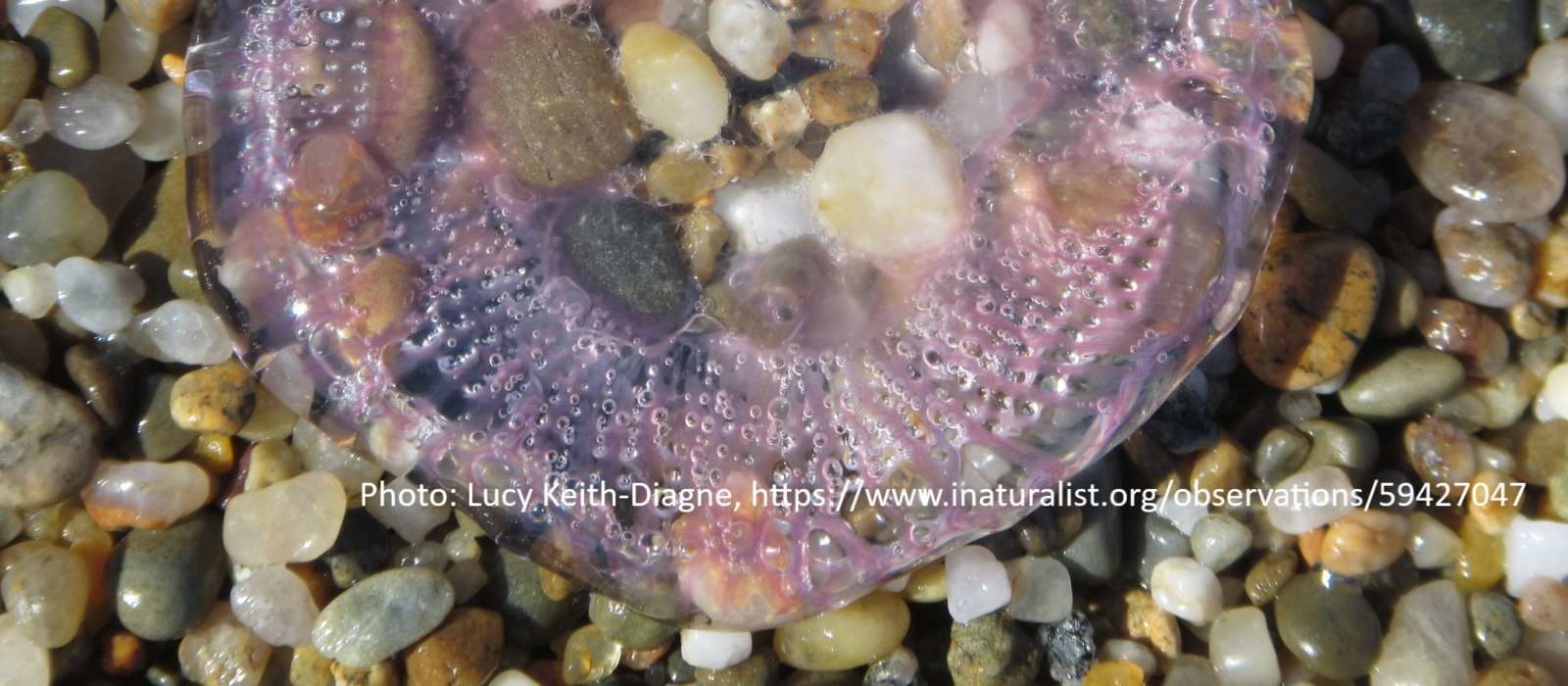Lower Invertebrates: Phyla Porifera, Cnidaria, Ctenophora
The invertebrates in this section belong to an array of phyla, and the species listed below are all aquatic and mostly marine. We refer to them here as lower invertebrates because they have simple body plans without true body cavities and occur near the base of the animal kingdom’s phylogenetic tree. They therefore have a common ancestor (about 800 million years ago) with all vertebrates, including humans (Dohrmann and Wörheide 2017).
Phylum Porifera: Sponges
There are about 5,000 living species in the phylum Porifera, falling into three classes: the Hexactinellida (glass sponges), the Demospongiae, and the Calcarea (calcareous sponges) (Collins 1998). The Demospongiae account for 90% of extant species, as well as the vast majority of recorded species surrounding Martha’s Vineyard (Collins 1998). Our list includes only one representative for each of the other two classes.
Porifera are the simplest multi-cellular animals, having no true tissues, internal organs, muscles, circulatory system, or nervous system (Ianni 2005). Instead, most sponges filter feed through outer walls, moving water through the body. Porifera are so called because of the unique pores through which the animals feed, filtering nutrients and oxygen out and then releasing the water through larger openings. Beating flagella move the water through the organism (Collins 1998). Sponges are benthic, living on the bottom of the ocean or other body of water.
Phylum Cnidaria: Corals, Sea anemones, Jellyfish
Cnidarians are a diverse group of 9,000 aquatic species (“Cnidaria,” 2015). All species in the phylum are radially symmetric and take one of two body forms: either the polyp or the medusa. Polyps, such as sea anemones, are sessile with an upwards facing mouth, while medusae are mobile bell-shaped organisms, such as jellyfish, with a downward facing mouth. The body forms are essentially the flipped versions of one another. Medusae move through water by expanding and contracting muscles in their bell. All species in the phylum are also carnivorous, actively or passively feeding depending on body form (Fauntin and Romano 1997).
Cnidarians fall into four main classes. Anthozoans include sea anemones and corals, all of which remain sessile polyps throughout their life cycles. Cubuzoa are box jellies, named for their box-shaped medusae. These are the most venomous group of cnidarian. Scyphozoans are typical jellyfish, with a prominent medusal phase after a shorter polyp growth phase in the life cycle. Hydrozoa are also polymorphic, with a diversity of morphologies united by the derivation of their gonads from epidermal tissue (Fauntin and Romano 1997).
One hydrozoan, Gonionemus vertens, has received a lot of attention on Martha’s Vineyard in recent years. It is a highly toxic species that has recently become more abundant in the island’s ponds, and multiple sting incidents have been reported. A recent study by WHOI researcher Mary Carman found the species in Farm Pond, Sengekontacket Pond, Lake Tashmoo, Stonewall Pond, and Edgartown Great Pond (Carman et al. 2019).
Phylum Ctenophora: Comb Jellies
Ctenophores, or comb jellies, make up a small group of about 200 marine species (Wright 2014). The name ctenophore refers to the rows of cilia, or “combs,” that beat to propel the gelatinous animals through water. Unlike cnidarians, they do not possess stinging cells. They are, however, carnivorous like cnidarians. Most species use a pair of sticky tentacles to catch small zooplankton (Mills 2010). Body shapes are diverse and vary among environments. Coastal species tend to be more robust due to the wave action that they must withstand, while pelagic species are often more fragile (Wright 2014).
Ctenophores can be fairly inconspicuous due to their small size and transparency. However, when in motion, many species create seemingly bioluminescent rainbows of color. The effect is in fact created by light diffraction off of the rows of cilia, creating rainbows of light that move down the comb jelly’s body. Many species are also bioluminescent, but this can only be seen in darkness (Mills 2010).
Allan Keith; edited by Matt Pelikan, February 7, 2022
References
Carman, M., Grunden, D., Reddington, E., and Govindarajan, A. (2019). Distribution of the highly toxic clinging jellyfish Gonionemus sp. around the island of Martha’s Vineyard, Massachusetts, USA. Marine Biodiversity Records, 12(1), 1-8.
“Cnidaria.” (2015). Marine Education Society of Australasia. http://www.mesa.edu.au/Cnidaria/default.asp
Collins, A. (1998). “Introduction to Porifera.” https://ucmp.berkeley.edu/porifera/porifera.html
Dohrmann, M., and Wörheide, G. (2017). Dating early animal evolution using phylogenomic data. Scientific Reports. 7. 3599.
Fauntin, D.G., and Romano, S. L. (1997). “Cnidaria”. Tree of Life Web Project, http://tolweb.org/Cnidaria
Hayes, R., and Goreau, N. (1977). Intracellular crystal-bearing vesicles in the epidermis of scleractinian corals, Astrangia danae (Agassiz) and Porites porites (Pallas). The Biological Bulletin, 152(1), 26-40.
Ianni, S. (2005). “All about sponges.” Tree of Life Web Project, http://tolweb.org/treehouses/?treehouse_id=3431
Mills, C. E. (2010). “Ctenophores.” https://faculty.washington.edu/cemills/Ctenophores.html
Wright, J. (2014). “Ctenophora.” Animal Diversity Web. https://animaldiversity.org/accounts/Ctenophora/
Yale Peabody Museum of Natural History Collections Database. https://collections.peabody.yale.edu/search/
